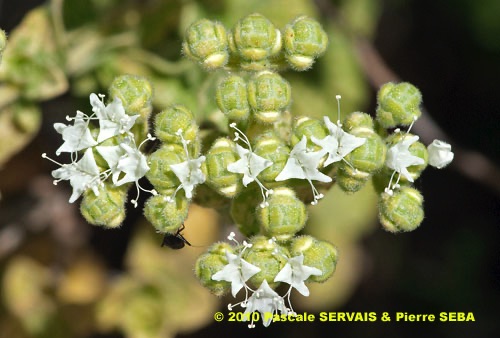
Origanum onites L.
Fam. : Lamiaceae
© Pascale SERVAIS & Pierre SEBA, 2018. Tilo Botanica: Flore de Tilos et du Dodécanèse / Flora of Tilos and of the Dodecanese
English translation by Brenda Bradbury, Howard Bradbury and Stéphane Léonard
Arbrisseau hermaphrodite, très aromatique, à tiges poilues et couvertes de petites cloques.
Feuilles opposées, simples, ovales à cordiformes, entières ou peu dentées, de 10 à 22 mm de long, duveteuses. Feuilles inférieures à court pétiole, feuilles supérieures sessiles.
Fleurs à symétrie bilatérale, blanches ou roses, de 4 à 5 mm de long, réunies en bouquets aplatis formant de larges corymbes. Corolle à 2 lèvres, entourée de nombreuses bractées ovales à orbiculaires et très imbriquées, la lèvre supérieure entière ou légèrement bilobée et la lèvre inférieure trilobée. Calice à 1 lèvre, fendu profondément d’un côté. 4 étamines saillantes. Ovaire supère à 4 ovules.
Fruits, 4 akènes oblongs.
___________________________
Shrub hermaphrodite, very aromatic. Stems hairy, covered in small blisters.
Leaves opposite, simple, ovate to heart-shaped, entire or little toothed, from 10 to 22 mm long, hoary. Lower leaves with a short petiole, upper leaves sessile.
Flowers bilaterally symmetrical, white or pink, from 4 to 5 mm long, joined together in flattened clusters forming wide corymbs. Corolla two-lipped, surrounded by numerous, ovate to orbicular and very imbricate bracts, the upper lip entire or slightly two-lobed, the lower lip three-lobed. Calyx with 1 lip, deeply split on one side. 4 protruding stamens. Ovary superior with 4 ovules.
Fruits, 4 oblong achenes.
Descripteurs / Identifying features
1
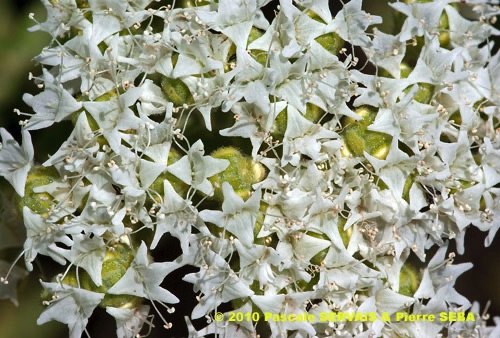
2
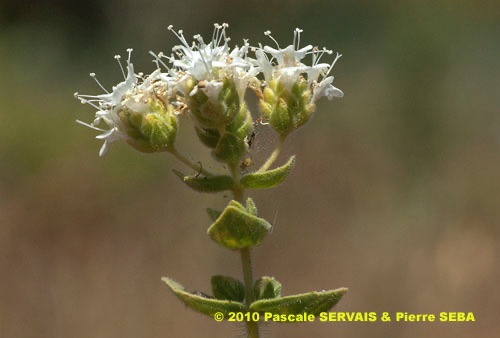
3
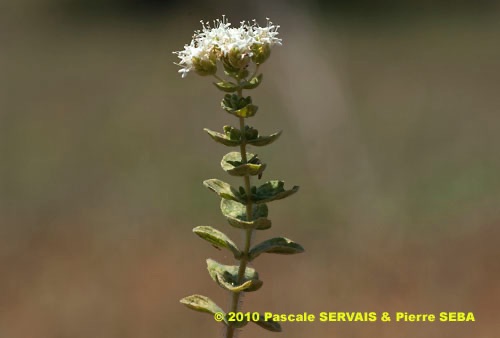
4
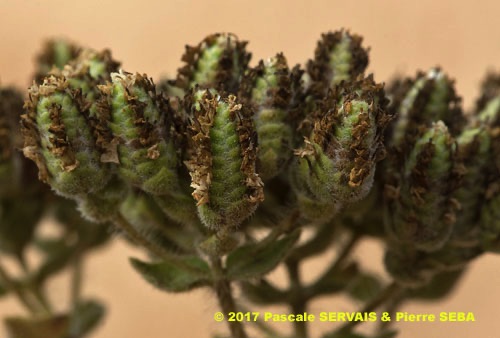
5
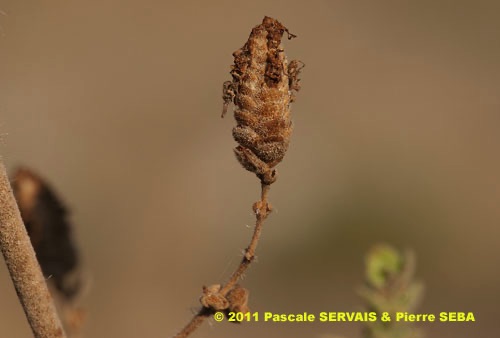
6
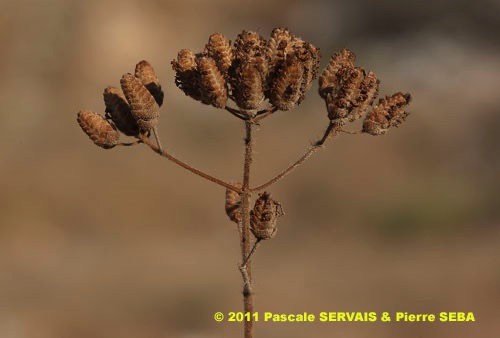
7
Étymologie / Etymology :
Origanum : emprunt du latin origanum, -i (nom) = l’origan, nom donné à
la plante par Pline, naturaliste latin mort en 79 apr. J.-C., forme
latinisée du grec ancien ορίγανος, -ου (nom) [ < ὄρος, -ους (nom)
= la montagne + γάνος, -ους (nom) = l’éclat, l’aspect radieux, la joie ]
= l’origan, l’éclat des montagnes, en référence à l’éclat de ses fleurs
dans le paysage.
Onites : emprunt du latin onitis, -idis (nom) = l’origan, nom donné à une
espèce d’origan par Pline, naturaliste latin mort en 79 apr. J.-C., forme
latinisée du grec ancien ὀνῖτις, -ιδος (nom) = l’origan, nom donné à
la plante par Dioscoride, médecin et botaniste grec mort
en 90 apr. J.-C.
Origanum : borrowed from Latin origanum, -i (noun) = oregano, name
given to the plant by Plinius, Latin naturalist died in 79 AD, Latinized
form of the Classical Greek ορίγανος, -ου (noun) [ < ὄρος, -ους (noun)
= mountain + γάνος, -ους (noun) = vividness, radiant aspect, joy ]
= oregano, vividness of mountains, referring to the brightness of the
flowers in the landscape.
Onites : borrowed from Latin onitis, -idis (noun) = oregano, name given
to a species of oregano by Plinius, Latin naturalist died in 79 AD,
Latinized form of the Classical Greek ὀνῖτις, -ιδος (noun) = oregano,
name given to the plant by Dioscorides, Greek doctor and botanist died
in 90 AD.
Synonymes / Synonyms :
Majorana onites (L.) Benth.
Origanum smyrnaeum L.
Noms vernaculaires / Common names :
Noms français / French names :
Origan de Chypre — Origan onites.
Noms grecs / Greek names :
Ορίγανο η ονήτις — Ρίγανη — Ρίγανη η λευκή —
Ρίγανη η νησιώτικη — Τούρκικη ρίγανη.
Noms anglais / English names :
Cretan oregano — French marjoram — Pot marjoram — Rigani —
Smyrna oregano — Turkish oregano — White marjoram.
Noms allemands / German names :
Etwa Kreta-Oregano — Französischer Majoran — Kretischer Dost —
Kretischer oregano — Onitesdost — Ragani — Rigani —
Spanischer Hopfen — Topforegano — Türkischer Oregano.
Nom espagnol / Spanish name :
Orégano.
Noms italiens / Italian names :
Origano — Origano siciliano.
Habitat :
Lieux pierreux - Lieux incultes - Chemins.
Stony places - Waste ground - Waysides.
Île / Island :
Tilos.
Hauteur / Height range :
De 30 cm à 70 cm.
From 30 cm to 70 cm.
Floraison / Flowering time :
De mai à septembre.
From May to September.
Groupe / Classification :
Dicotylédones.
Dicotyledons.
Pérennité / Lifespan :
Vivace.
Perennial.
Description :
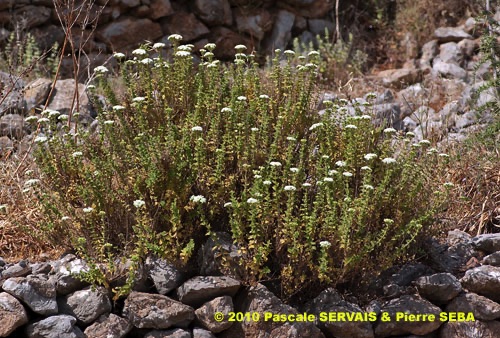
8
Photo 1 :
Localisation / Location : Tilos, Livadia, Aghios Stephanos
Date : 07/05/2010
GPS : Lat. 36,40824° N / Long. 27,39548° E / Alt. 8 m
Type : Photographie numérique / Digital Photograph (10 mégapixels)
Photo 2 :
Localisation / Location : Tilos, Livadia, Aghios Stephanos
Date : 07/05/2010
GPS : Lat. 36,40824° N / Long. 27,39548° E / Alt. 8 m
Type : Photographie numérique / Digital Photograph (10 mégapixels)
Photo 3 :
Localisation / Location : Tilos, Livadia, Aghios Stephanos
Date : 07/05/2010
GPS : Lat. 36,40824° N / Long. 27,39548° E / Alt. 8 m
Type : Photographie numérique / Digital Photograph (10 mégapixels)
Photo 4 :
Localisation / Location : Tilos, Livadia, Aghios Stephanos
Date : 07/05/2010
GPS : Lat. 36,40824° N / Long. 27,39548° E / Alt. 8 m
Type : Photographie numérique / Digital Photograph (10 mégapixels)
Photo 5 :
Localisation / Location : Tilos, Livadia, Village
Date : 08/06/2017
GPS : Lat. 36,41000° N / Long. 27,38845° E / Alt. 26 m
Type : Photographie numérique / Digital Photograph (24 mégapixels)
Photo 6 :
Localisation / Location : Tilos, Megalochorio, Aghios Andonis
Date : 25/09/2011
GPS : Lat. 36,45823° N / Long. 27,33506° E / Alt. 7 m
Type : Photographie numérique / Digital Photograph (10 mégapixels)
Photo 7 :
Localisation / Location : Tilos, Megalochorio, Aghios Andonis
Date : 25/09/2011
GPS : Lat. 36,45823° N / Long. 27,33506° E / Alt. 7 m
Type : Photographie numérique / Digital Photograph (10 mégapixels)
Photo 8 :
Localisation / Location : Tilos, Livadia, Village
Date : 08/05/2010
GPS : Lat. 36,41000° N / Long. 27,38845° E / Alt. 26 m
Type : Photographie numérique / Digital Photograph (10 mégapixels)

Google Maps
Google Maps
Google Maps
Google Maps
Google Maps
Google Maps
Google Maps
Google Maps